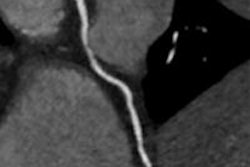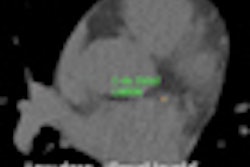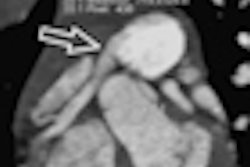The task at hand in CT radiation dose reduction is pretty straightforward: Record the dose, establish best practices for using it, and then use the right dose for every scan. But in reality these goals are so complex as to be nearly impossible, said Dr. R. Paul Guillerman of Texas Children's Hospital in Houston.
Guillerman addressed the myriad uncertainties and challenges facing radiologists trying to optimize radiation dose in pediatric CT in a wide-ranging talk at last month's Society for Pediatric Radiology (SPR) meeting in San Francisco. An easier future is on the horizon, he said, but it is not yet in clinicians' hands. It's likely to remain a future goal until CT scanners become much more sophisticated than they are now.
"The future of dose reduction boils down to collaboration with medical physicists, and the whole thrust of this collaboration is dose optimization," Guillerman said.
Where are we now?
Dose reduction really means dose optimization, or "attaining the highest image quality at the lowest dose," he said. So where are we now?
"In 2012, you can worry about us having gone too far -- maybe some diagnoses are being missed because of overaggressive attempts at dose reduction," Guillerman said. Dose reduction leading to nondiagnostic images actually causes more harm than standard-dose imaging if the patient winds up needing a repeat scan. Technological advances can be helpful, but they also create a moving target that makes protocols and best practices notoriously difficult to nail down, he said.
A perfect storm of mistakes by radiology providers, coverage in the news media, and regulatory action has led to a renewed impetus to measure dose and, by doing so, establish best practices for the use of medical radiation.
But the task is easier said than done. First, clinical practice is highly granular in that each patient is different, and "you really don't have a way to say what dose a patient got," Guillerman said. "Sure, we can calculate effective doses, but that wasn't the intent of the effective dose, and we really don't know what the organ doses are for the individual patient -- and if you want to measure something, how can you do that if you don't have a standard to express it?"
Add those uncertainties to a general lack of understanding about the true risk of radiation exposure, and you're left with a lot of guessing. There are dose thresholds, but they're arbitrary, he said. And in any case, what is too much risk, what is too much dose, and what is acceptable image quality? It's often an open question.
Dose reference values express what is used in practice, but they're certainly not optimal. And while the general principles of CT dose optimization are known, details are lacking. These principles include the following:
- Base scan settings on size, region, and clinical indication
- Optimize energy spectra and contrast
- Use tube current modulation appropriately
- Select appropriate section thickness and reconstruction technique
In practice, it can be difficult to implement tube current modulation appropriately based on noise levels, he said.
For example, low kVp doesn't work for every application. Set too low, kVp can produce excessive noise and artifacts (streak, beam hardening, motion), especially in large patients, Guillerman said. More guidance is needed on thresholds, and very few publications offer concrete rules to follow.
Kalender and colleagues (Medical Physics, 2009) used spectral optimization for thoracic CT to choose the tube voltage that minimizes a patient dose at a given contrast-to-noise ratio or maximizes the ratio at a given dose. But radiologists should target their efforts toward elements that have a k edge, where the goal is to match the mean spectra of two elements such as iodinated contrast and calcium, Guillerman said.
What often happens, however, is that kVp is being reduced inappropriately on noncontrast CT, when the breadth of the contrast-to-noise ratio per dose doesn't point to an improvement in image quality. To improve matters, radiologists generally need to make more concerted efforts to assess the diagnostic target when attempting to set the optimal tube voltage, he said.
Charts based on patient age, height, or weight have long been used to set tube voltage, but these techniques are really suboptimal, Guillerman said. And there's a better way: Medical physicist Keith Strauss, PhD, showed attendees at this year's SPR meeting how measuring a patient's cross-sectional size is superior to using height, weight, or age to adjust exposure levels, Guillerman said. Another study demonstrated how 80 kV is acceptable for patients with a lateral width of 36 cm or less, but 100 kV works better for widths of 41 cm or less.
When exposure is inadequate, the use of different reconstruction kernels can also help fix nondiagnostic images, as can the reconstruction of thick slabs, he said.
Tube current modulation: An imperfect tool
Tube current modulation (TCM) has its own idiosyncrasies as a dose-reduction tool, Guillerman said, beginning with the fact that TCM doesn't reduce the dose per se.
"Tube current modulation seems great at first because you're trying to equalize noise, but that's not really what you want to do; in some organs you can tolerate a lot more noise than others," Guillerman said. The optimal noise settings are influenced by patient size, body section, and clinical indication.
A better solution than today's TCM would be to modulate tube current on an organ-by-organ basis -- a solution that will be possible in future CT scanners. But so-called "interior CT" is still years away, he said.
"What do we do until then? I was shocked to learn how much patient positioning and the topogram have to do with radiation doses," Guillerman said.
A recent study showed that just a few centimeters' difference in patient positioning creates large dose differences due to changes in the bow-tie filtering.
Dose in TCM is also affected by the order and orientation of the localized radiographs, with different effects corresponding to different scanner models. There isn't enough documentation on this issue, either, making it imperative to know your scanner, Guillerman said.
And radiologists will want to note, per McCollough and colleagues at the American Academy of Physics in Medicine (AAPM) 2011 CT Dose Summit, that subjective image quality decreases with smaller patient diameter using TCM, creating the risk of unacceptable image quality in children, and excessive dose, tube heating, and longer scan times in larger patients, he said.
On the positive side, iterative reconstruction, now being performed by second-generation algorithms finding their way into vendors' portfolios, is increasingly being used in clinical practice. Recent studies have demonstrated dose reductions of 50% to 60% in the chest, 20% to 40% in the abdomen, and 10% to 20% in the head, Guillerman said.
A key problem with dose optimization is the vast number of operator-controlled parameters to set in today's CT scanners, which include mAs and kVp, pitch, scan length, field-of-view, acquisition mode, detector configuration, number of phases, TCM noise level, reconstruction thickness, reconstruction algorithm, and reconstruction kernel, he said.
"The bottom line on optimization is this extraordinary array of selections available on the scanner, and there's not a lot of guidance provided," Guillerman said. "We need a kind of autopilot to let us know what's been done on the scanner, and that's the role of the medical physicists we should collaborate with."
In its 2012 report on imaging equipment, research organization ECRI Institute presses that point, recommending that providers always have a medical physicist available to offer guidance to radiologists and technologists alike on image quality and dose based on patient anatomy and size, as well as the purpose of the scan, Guillerman said.
"I'd love to see a CT console where you can say 'I want to achieve low-contrast detectability of this [finding] for this size lesion in this patient': that's the Holy Grail of what we'd like to see," Guillerman said. "There's been some preliminary work done in various publications where people have figured this out for certain phantom sizes and for simulated lesions, but it really needs to be done on a more global basis for different scanners, different vendors, different patient sizes, and so forth. That's where I hope to see the future going."



















